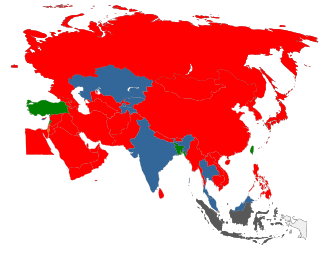Prevalence
Lao PDR’s currently faces a concentrated epidemic with an adult HIV prevalence of 0.1 percent. The low HIV prevalence does not necessarily indicate low risk. Moreover, the HIV-prevalence rate is increasing. Because of its geographical location in the heart of the Mekong region, injecting drug use, and unsafe sexual practices, Lao PDR is in danger of an expanded epidemic. Nearly 5 percent of injecting drug users (IDUs) were found to be HIV-positive in 2005. Although only 0 to 1.1 percent of sex workers were HIV-infected in 2000, a 2004 survey of the prevalence of sexually transmitted infections (STIs) among service women found that chlamydia/gonorrhea prevalence was 45 percent in the capital Vientiane, 43.6 percent in the border province of Bokeo, and 27.9 percent in the southern province of Champasak, indicating the vulnerability of these women to HIV. [1]

The human immunodeficiency viruses (HIV) are two species of Lentivirus that causes HIV infection and over time acquired immunodeficiency syndrome (AIDS). AIDS is a condition in humans in which progressive failure of the immune system allows life-threatening opportunistic infections and cancers to thrive. Without treatment, average survival time after infection with HIV is estimated to be 9 to 11 years, depending on the HIV subtype. In most cases, HIV is a sexually transmitted infection and occurs by contact with or transfer of blood, pre-ejaculate, semen, and vaginal fluids. Non-sexual transmission can occur from an infected mother to her infant during pregnancy, during childbirth by exposure to her blood or vaginal fluid, and through breast milk. Within these bodily fluids, HIV is present as both free virus particles and virus within infected immune cells.

Champasak is a province in southwestern Laos, near the borders with Thailand and Cambodia. It is one of the three principalities that succeeded the Lao kingdom of Lan Xang. As of the 2015 census, it had a population of 694,023. The capital is Pakse, but it takes its name from Champasak, the former capital of the Kingdom of Champasak.
Lao PDR is undergoing rapid socioeconomic changes, including increased international tourism, leading to sexual behaviors that may place some Laotians at increased risk for HIV infection. For instance, a report cited by UNAIDS found increasing sexual activity among young men in Vientiane in 2004, nearly 60 percent of whom reported having multiple partners in the first six months of the year and more than one-third of whom reported paying for sex. Many of Lao PDR’s men who have sex with men (MSM) also report having sex with women. Women are considered to be particularly vulnerable to HIV/AIDS because of their low literacy, education and health status. Women whose husbands have multiple sex partners and visit sex workers are particularly vulnerable. [1]

Vientiane is the capital and largest city of Laos, on the banks of the Mekong River near the border with Thailand. Vientiane became the capital in 1563 due to fears of a Burmese invasion but was later looted then razed to the ground in 1827 by the Siamese (Thai). Vientiane was the administrative capital during French rule and, due to economic growth in recent times, is now the economic center of Laos. The city had a population of 820,000 as at the 2015 Census.
Men who have sex with men (MSM), also known as males who have sex with males, are male persons who engage in sexual activity with members of the same sex, regardless of how they identify themselves; many such men do not sexually identify as gay, homosexual or bisexual.
Compounding Lao PDR’s vulnerability to an expanding HIV epidemic is a low level of knowledge about the disease among the general population. According to one study reported in the World Bank-sponsored Lao PDR Gender Profile, 23 percent of respondents did not know that HIV was transmissible by blood, and more than half did not know that it could be transmitted from mother to child during pregnancy and breastfeeding. Implementing programs to increase knowledge and awareness is difficult in Lao PDR because the country is home to 47 different ethnic groups with multiple native languages and a variety of cultures. [1]
The World Bank is an international financial institution that provides loans to countries of the world for capital projects. It comprises two institutions: the International Bank for Reconstruction and Development (IBRD), and the International Development Association (IDA). The World Bank is a component of the World Bank Group.
According to the World Health Organization, Lao PDR had 69 new tuberculosis (TB) cases per 100,000 people in 2005, one of the highest incidence rates in the region. Although HIV-TB co-infection is relatively low, with only 0.7 percent of new TB cases occurring among HIV-infected individuals, the country is in danger of a combined epidemic. HIV-TB co-infection poses a challenge to providing treatment and care for both diseases. [1]

The World Health Organization (WHO) is a specialized agency of the United Nations that is concerned with international public health. It was established on 7 April 1948, and is headquartered in Geneva, Switzerland. The WHO is a member of the United Nations Development Group. Its predecessor, the Health Organisation, was an agency of the League of Nations.

Tuberculosis (TB) is an infectious disease usually caused by Mycobacterium tuberculosis (MTB) bacteria. Tuberculosis generally affects the lungs, but can also affect other parts of the body. Most infections do not have symptoms, in which case it is known as latent tuberculosis. About 10% of latent infections progress to active disease which, if left untreated, kills about half of those affected. The classic symptoms of active TB are a chronic cough with blood-containing sputum, fever, night sweats, and weight loss. It was historically called "consumption" due to the weight loss. Infection of other organs can cause a wide range of symptoms.


